

Nestled in the heart of the majestic Karakoram mountain range, the Hussaini Suspension Bridge is located in Hunza, a valley that has long captured the imaginations of travelers and adventurers. The history of tourism in this region can be traced back to the ancient Silk Road era when caravans passed through this corridor, mingling cultures and exchanging goods.
In recent history, tourism in Hunza and around the Hussaini Suspension Bridge began to flourish with the completion of the Karakoram Highway in the 1970s, providing overland access to remote regions of Northern Pakistan. The bridge itself, often dubbed as one of the most dangerous in the world, gained attention for its precarious ropes and sparse wooden planks suspended high above the Hunza River.
The relative isolation of the Husaini area preserved its natural beauty and cultural heritage, which attracted trekkers, cultural enthusiasts, and thrill-seekers. Although not a mass tourist destination, the bridge has been a highlight for intrepid travelers seeking the road less traveled.
In the age of social media and digital nomadism, Hunza, and by extension, the Hussaini Suspension Bridge, have seen a new wave of interest. The latest trend is to capture the challenging crossing experience on camera, often sharing it on platforms like Instagram and YouTube to showcase the adventurous spirit of the Pakistani highlands.
Another trend affecting tourism in the area is the increasing emphasis on sustainable and eco-friendly travel. Tourists are more environmentally conscious, seeking accommodations and experiences that minimize their impact on the pristine mountain ecosystems. This has spurred a movement towards eco-tourism in the Hunza Valley, with local entrepreneurs creating initiatives that promise both adventure and sustainability.
Efforts to promote community-based tourism have also taken root, enriching visitors' experiences by engaging them more deeply with the local communities, their culture, and traditions. This includes homestays, local guides, and cultural exchanges that provide a more authentic insights into the life of Hunza.
For those planning to visit, it is important to be aware of both the physical challenge and the cultural significance of the bridge. The journey across requires a steady foot and a brave heart. Furthermore, the bridge is not just a tourist spectacle but also a vital part of the local infrastructure, connecting communities and serving as a lifeline for the villages it joins.
The best time to visit is during the late spring and summer months when the weather is most accommodating. Visitors are encouraged to respect the natural environment and the local culture, leaving no trace and taking only memories.
Finally, the government of Pakistan has invested in tourism infrastructure, improving safety and access while maintaining the raw appeal of the region. These developments promise a bright future for the sustainable growth of tourism in Hunza and around the Hussaini Suspension Bridge.